Abstract
BACKGROUND: In the United Kingdom (UK), 9% of adults consult their doctor annually with back pain. The treatment recommendations are based on orthopaedic teaching, but the current management is causing increasing dissatisfaction. Many general practitioners (GPs) are confused about what constitutes effective advice. AIM: To review all randomized controlled trials of bed rest and of medical advice to stay active for acute back pain. METHOD: A systematic review based on a search of MEDLINE and EMBASE from 1966 to April 1996 with complete citation tracking for randomized controlled trials of bed rest or medical advice to stay active and continue ordinary daily activities. The inclusion criteria were: primary care setting, patients with low back pain of up to 3 months duration, and patient-centred outcomes (rate of recovery from the acute attack, relief of pain, restoration of function, satisfaction with treatment, days off work and return to work, development of chronic pain and disability, recurrent attacks, and further health care use). RESULTS: Ten trials of bed rest and eight trials of advice to stay active were identified. Consistent findings showed that bed rest is not an effective treatment for acute low back pain but may delay recovery. Advice to stay active and to continue ordinary activities results in a faster return to work, less chronic disability, and fewer recurrent problems. CONCLUSION: A simple but fundamental change from the traditional prescription of bed rest to positive advice about staying active could improve clinical outcomes and reduce the personal and social impact of back pain.
Full text
PDF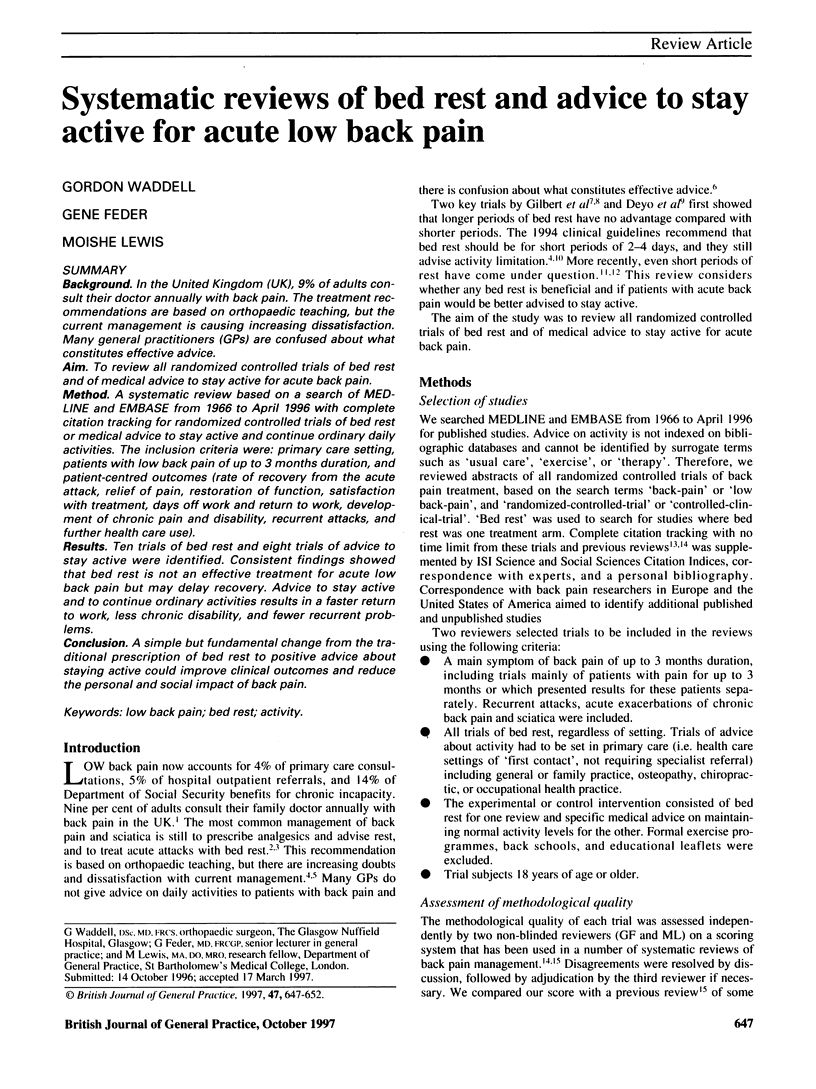
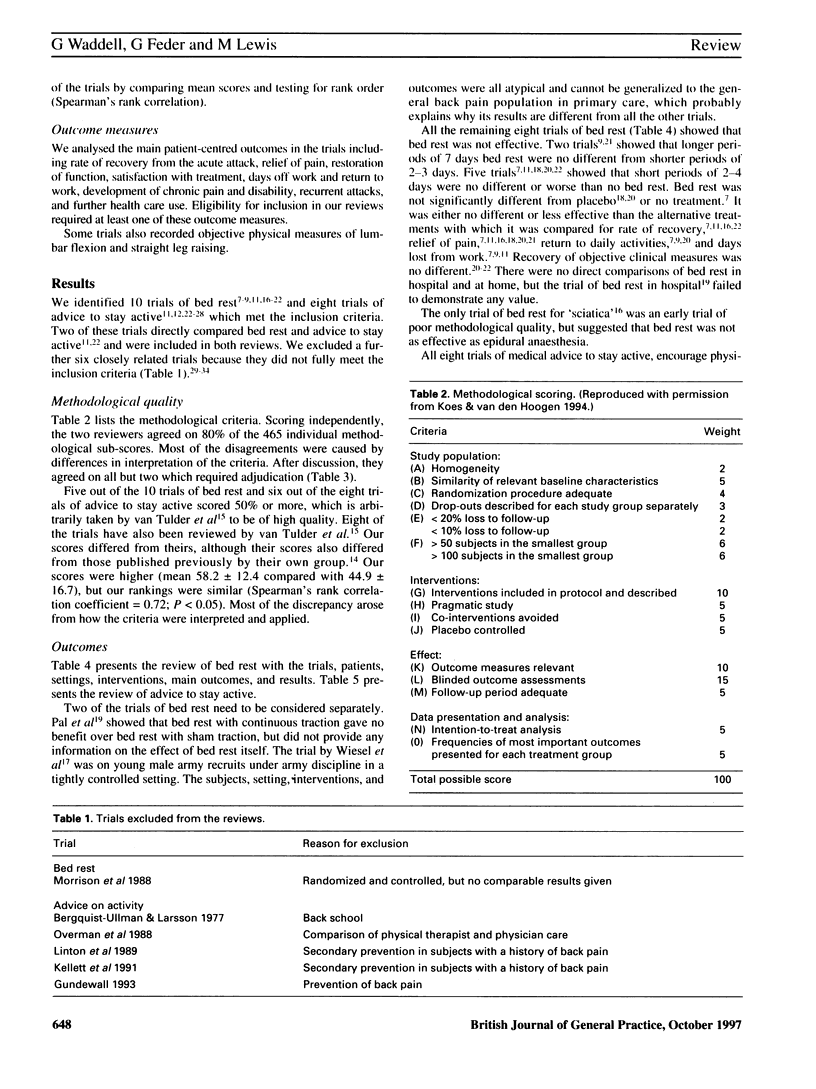
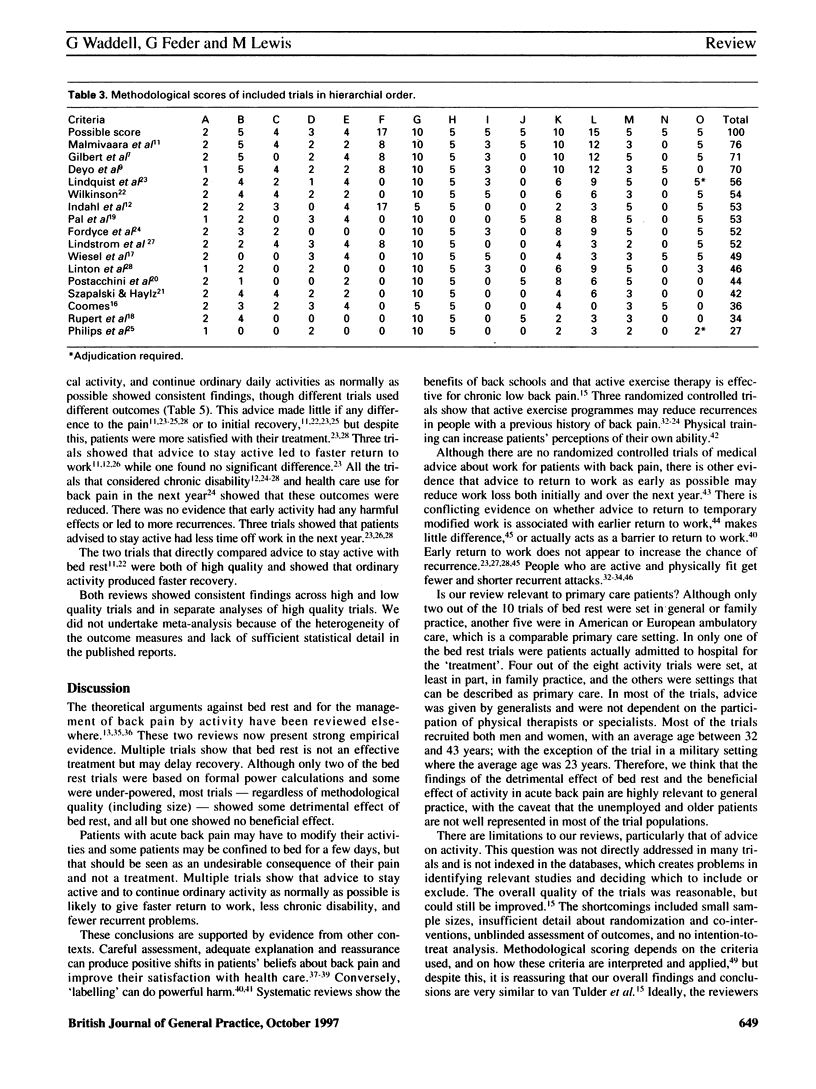
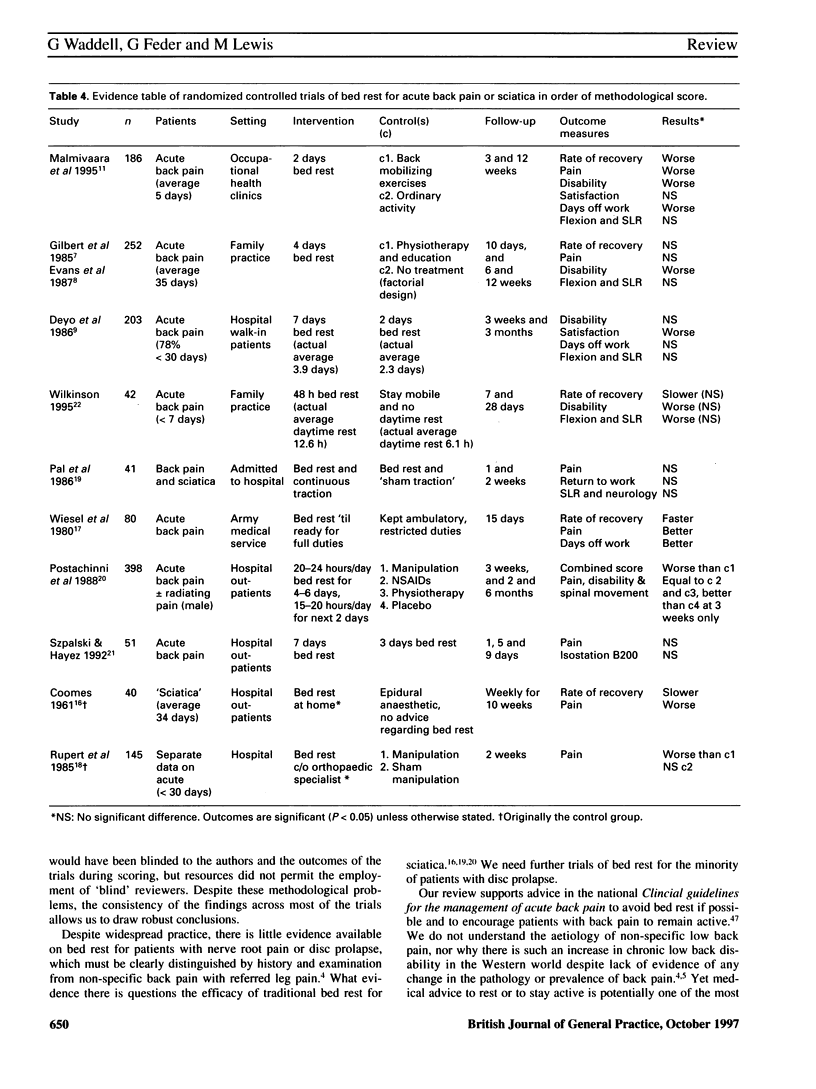
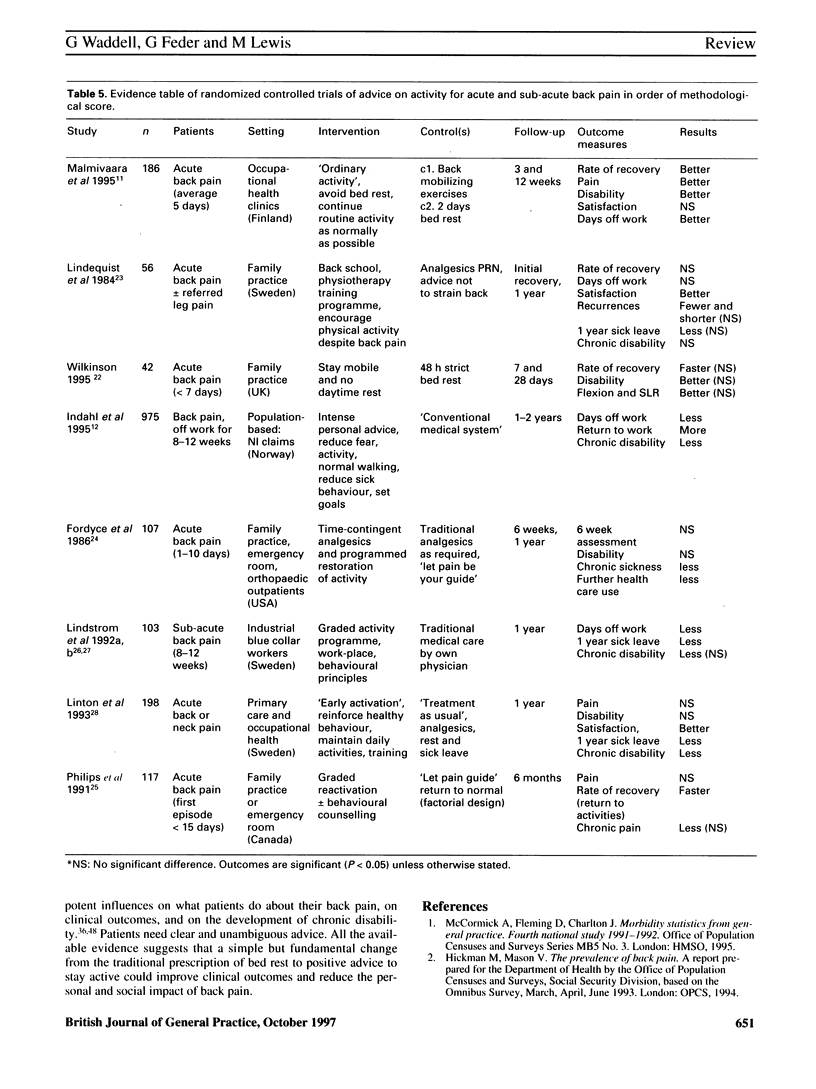
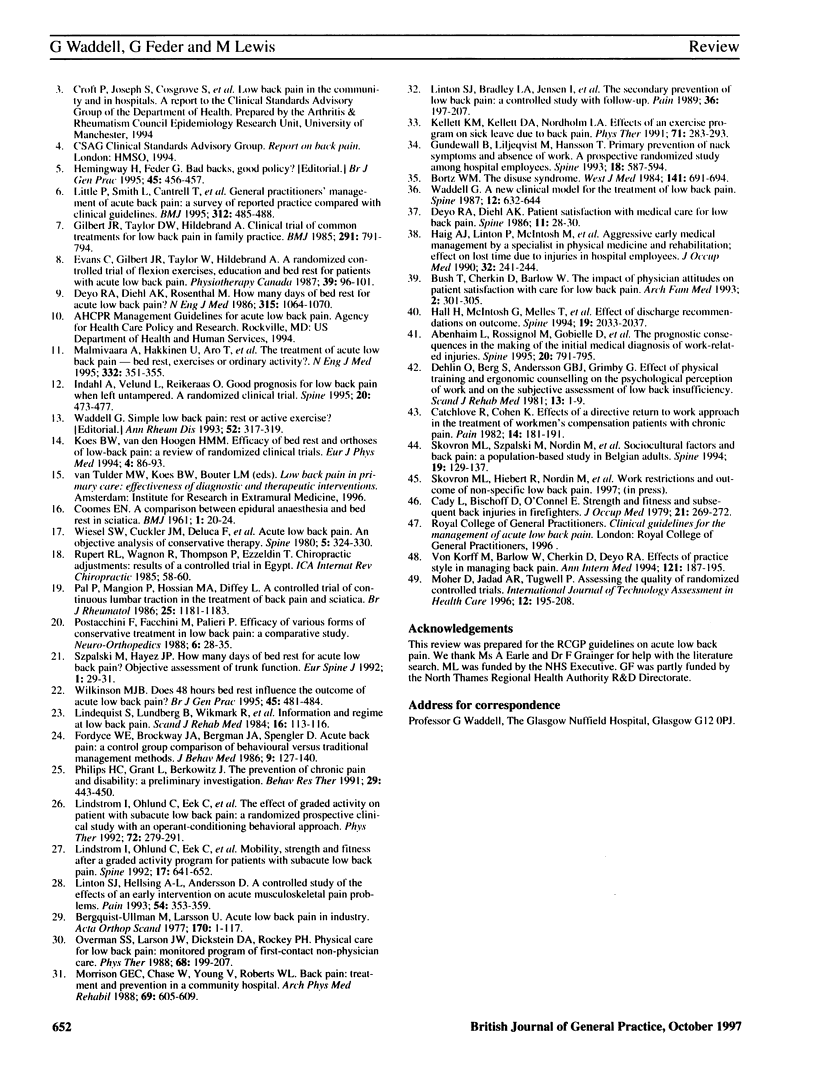
Selected References
These references are in PubMed. This may not be the complete list of references from this article.
- Abenhaim L., Rossignol M., Gobeille D., Bonvalot Y., Fines P., Scott S. The prognostic consequences in the making of the initial medical diagnosis of work-related back injuries. Spine (Phila Pa 1976) 1995 Apr 1;20(7):791–795. doi: 10.1097/00007632-199504000-00010. [DOI] [PubMed] [Google Scholar]
- Bortz W. M., 2nd The disuse syndrome. West J Med. 1984 Nov;141(5):691–694. [PMC free article] [PubMed] [Google Scholar]
- Bush T., Cherkin D., Barlow W. The impact of physician attitudes on patient satisfaction with care for low back pain. Arch Fam Med. 1993 Mar;2(3):301–305. doi: 10.1001/archfami.2.3.301. [DOI] [PubMed] [Google Scholar]
- COOMES E. N. A comparison between epidural anaesthesia and bed rest in sciatica. Br Med J. 1961 Jan 7;1(5218):20–24. doi: 10.1136/bmj.1.5218.20. [DOI] [PMC free article] [PubMed] [Google Scholar]
- Cady L. D., Bischoff D. P., O'Connell E. R., Thomas P. C., Allan J. H. Strength and fitness and subsequent back injuries in firefighters. J Occup Med. 1979 Apr;21(4):269–272. [PubMed] [Google Scholar]
- Catchlove R., Cohen K. Effects of a directive return to work approach in the treatment of workman's compensation patients with chronic pain. Pain. 1982 Oct;14(2):181–191. doi: 10.1016/0304-3959(82)90098-7. [DOI] [PubMed] [Google Scholar]
- Dehlin O., Berg S., Andersson G. B., Grimby G. Effect of physical training and ergonomic counselling on the psychological perception of work and on the subjective assessment of low-back insufficiency. Scand J Rehabil Med. 1981;13(1):1–9. [PubMed] [Google Scholar]
- Deyo R. A., Diehl A. K. Patient satisfaction with medical care for low-back pain. Spine (Phila Pa 1976) 1986 Jan-Feb;11(1):28–30. doi: 10.1097/00007632-198601000-00008. [DOI] [PubMed] [Google Scholar]
- Deyo R. A., Diehl A. K., Rosenthal M. How many days of bed rest for acute low back pain? A randomized clinical trial. N Engl J Med. 1986 Oct 23;315(17):1064–1070. doi: 10.1056/NEJM198610233151705. [DOI] [PubMed] [Google Scholar]
- Fordyce W. E., Brockway J. A., Bergman J. A., Spengler D. Acute back pain: a control-group comparison of behavioral vs traditional management methods. J Behav Med. 1986 Apr;9(2):127–140. doi: 10.1007/BF00848473. [DOI] [PubMed] [Google Scholar]
- Gilbert J. R., Taylor D. W., Hildebrand A., Evans C. Clinical trial of common treatments for low back pain in family practice. Br Med J (Clin Res Ed) 1985 Sep 21;291(6498):791–794. doi: 10.1136/bmj.291.6498.791. [DOI] [PMC free article] [PubMed] [Google Scholar]
- Gundewall B., Liljeqvist M., Hansson T. Primary prevention of back symptoms and absence from work. A prospective randomized study among hospital employees. Spine (Phila Pa 1976) 1993 Apr;18(5):587–594. doi: 10.1097/00007632-199304000-00011. [DOI] [PubMed] [Google Scholar]
- Haig A. J., Linton P., McIntosh M., Moneta L., Mead P. B. Aggressive early medical management by a specialist in physical medicine and rehabilitation: effect on lost time due to injuries in hospital employees. J Occup Med. 1990 Mar;32(3):241–244. doi: 10.1097/00043764-199003000-00011. [DOI] [PubMed] [Google Scholar]
- Hall H., McIntosh G., Melles T., Holowachuk B., Wai E. Effect of discharge recommendations on outcome. Spine (Phila Pa 1976) 1994 Sep 15;19(18):2033–2037. doi: 10.1097/00007632-199409150-00002. [DOI] [PubMed] [Google Scholar]
- Hemingway H., Feder G. Bad backs, good policy? Br J Gen Pract. 1995 Sep;45(398):456–457. [PMC free article] [PubMed] [Google Scholar]
- Indahl A., Velund L., Reikeraas O. Good prognosis for low back pain when left untampered. A randomized clinical trial. Spine (Phila Pa 1976) 1995 Feb 15;20(4):473–477. doi: 10.1097/00007632-199502001-00011. [DOI] [PubMed] [Google Scholar]
- Kellett K. M., Kellett D. A., Nordholm L. A. Effects of an exercise program on sick leave due to back pain. Phys Ther. 1991 Apr;71(4):283–293. doi: 10.1093/ptj/71.4.283. [DOI] [PubMed] [Google Scholar]
- Lindequist S., Lundberg B., Wikmark R., Bergstad B., Löf G., Ottermark A. C. Information and regime at low back pain. Scand J Rehabil Med. 1984;16(3):113–116. [PubMed] [Google Scholar]
- Lindström I., Ohlund C., Eek C., Wallin L., Peterson L. E., Fordyce W. E., Nachemson A. L. The effect of graded activity on patients with subacute low back pain: a randomized prospective clinical study with an operant-conditioning behavioral approach. Phys Ther. 1992 Apr;72(4):279–293. doi: 10.1093/ptj/72.4.279. [DOI] [PubMed] [Google Scholar]
- Lindström I., Ohlund C., Eek C., Wallin L., Peterson L. E., Nachemson A. Mobility, strength, and fitness after a graded activity program for patients with subacute low back pain. A randomized prospective clinical study with a behavioral therapy approach. Spine (Phila Pa 1976) 1992 Jun;17(6):641–652. doi: 10.1097/00007632-199206000-00003. [DOI] [PubMed] [Google Scholar]
- Linton S. J., Hellsing A. L., Andersson D. A controlled study of the effects of an early intervention on acute musculoskeletal pain problems. Pain. 1993 Sep;54(3):353–359. doi: 10.1016/0304-3959(93)90037-P. [DOI] [PubMed] [Google Scholar]
- Little P., Smith L., Cantrell T., Chapman J., Langridge J., Pickering R. General practitioners' management of acute back pain: a survey of reported practice compared with clinical guidelines. BMJ. 1996 Feb 24;312(7029):485–488. doi: 10.1136/bmj.312.7029.485. [DOI] [PMC free article] [PubMed] [Google Scholar]
- Malmivaara A., Häkkinen U., Aro T., Heinrichs M. L., Koskenniemi L., Kuosma E., Lappi S., Paloheimo R., Servo C., Vaaranen V. The treatment of acute low back pain--bed rest, exercises, or ordinary activity? N Engl J Med. 1995 Feb 9;332(6):351–355. doi: 10.1056/NEJM199502093320602. [DOI] [PubMed] [Google Scholar]
- Moher D., Jadad A. R., Tugwell P. Assessing the quality of randomized controlled trials. Current issues and future directions. Int J Technol Assess Health Care. 1996 Spring;12(2):195–208. doi: 10.1017/s0266462300009570. [DOI] [PubMed] [Google Scholar]
- Overman S. S., Larson J. W., Dickstein D. A., Rockey P. H. Physical therapy care for low back pain. Monitored program of first-contact nonphysician care. Phys Ther. 1988 Feb;68(2):199–207. doi: 10.1093/ptj/68.2.199. [DOI] [PubMed] [Google Scholar]
- Philips H. C., Grant L., Berkowitz J. The prevention of chronic pain and disability: a preliminary investigation. Behav Res Ther. 1991;29(5):443–450. doi: 10.1016/0005-7967(91)90128-p. [DOI] [PubMed] [Google Scholar]
- Skovron M. L., Szpalski M., Nordin M., Melot C., Cukier D. Sociocultural factors and back pain. A population-based study in Belgian adults. Spine (Phila Pa 1976) 1994 Jan 15;19(2):129–137. doi: 10.1097/00007632-199401001-00002. [DOI] [PubMed] [Google Scholar]
- Von Korff M., Barlow W., Cherkin D., Deyo R. A. Effects of practice style in managing back pain. Ann Intern Med. 1994 Aug 1;121(3):187–195. doi: 10.7326/0003-4819-121-3-199408010-00005. [DOI] [PubMed] [Google Scholar]
- Waddell G. 1987 Volvo award in clinical sciences. A new clinical model for the treatment of low-back pain. Spine (Phila Pa 1976) 1987 Sep;12(7):632–644. doi: 10.1097/00007632-198709000-00002. [DOI] [PubMed] [Google Scholar]
- Waddell G. Simple low back pain: rest or active exercise? Ann Rheum Dis. 1993 May;52(5):317–319. doi: 10.1136/ard.52.5.317. [DOI] [PMC free article] [PubMed] [Google Scholar]
- Wiesel S. W., Cuckler J. M., Deluca F., Jones F., Zeide M. S., Rothman R. H. Acute low-back pain. An objective analysis of conservative therapy. Spine (Phila Pa 1976) 1980 Jul-Aug;5(4):324–330. doi: 10.1097/00007632-198007000-00006. [DOI] [PubMed] [Google Scholar]
- Wilkinson M. J. Does 48 hours' bed rest influence the outcome of acute low back pain? Br J Gen Pract. 1995 Sep;45(398):481–484. [PMC free article] [PubMed] [Google Scholar]


